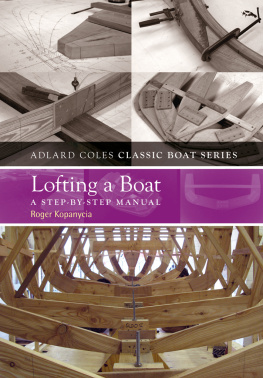

Lofting has been called an art, a science, technical/engineering drawing and also a form of magic and mysticism, but whats it really all about? Basically, its the process of creating a series of full-size drawings of a boat to allow it to be accurately and successfully constructed either by yourself or a boatyard. For many people, the thought of lofting a boat strikes them with fear, or they think its beyond their ability.
The aim of this book is to encourage anyone to have a go at lofting, by setting out a range of techniques that will work for any boat. It doesnt matter if you want to loft a 12 foot sailing dinghy, a 20 foot motor cruiser or a 60 foot deep-keeled, ocean-going yacht the range of skills and techniques are exactly the same; the only real difference is the size of the finished boat.
Originally trained as an engineer and now a qualified teacher, Ive worked as a lofting and boatbuilding instructor for over ten years, and have successfully passed on the skills and techniques needed to confidently loft a boat to hundreds of students.
Lofting is a visual activity and I cant understand why so many books (with a few notable exceptions) use lots of words but very few drawings. Hopefully, this book is the other way round: lots of drawings but not too many words. Theres a small glossary at the back, however, covering some of the basic terms youll need.
The book is divided into two parts..
, all of the techniques needed to achieve the end result are shown as a series of step-by-step drawings.
As with so many things in life, where there is rarely one single definitive way to carry out a task, lofting issues usually have a wealth of solutions. We all have opinions on the best way to get a job done, and the techniques described in this book are no exception. But all of the techniques and methods shown here have been used to successfully teach hundreds of students how to loft a boat.
Please visit my website at www.streamandshore.com, which has details of the lofting courses and one-to-one training that I can provide anywhere in the world to suit your needs.
Finally, Id like to thank all of the people who have encouraged me over the years to write this book, but in particular Allyn Burton and Olly Hodgson for their help in trialling the final draft, my brother Garry for his ability to look at the book from a laymans point of view, and finally Claire for her limitless patience and understanding.
Lofting is the process of drawing, or laying down, a boat, full size, in three different views, using information found in a Lines Drawing (a small-scale drawing of the boat) and an Offset Table (a table of measurements either created by the designer or taken from an original boat). These three views are:

The Profile View
A view of the boat from the side (ie its Profile) drawn onto a grid of horizontal Waterlines (WL) and vertical Station Lines (Stn).

The Body Plan
A series of vertical cross-sections through the hull drawn at the Stations. As a boat is typically symmetrical about its centreline (C/L), wed usually only draw in half of each Station cross-section.

The Half-breadth or Waterline View
A series of horizontal cross-sections through the hull at designated Waterlines.

As well as these views, there will also be the Buttock Lines (drawn in the Profile View) and the Diagonals (typically drawn below the Half-breadth View). Both of these lines, as youll see later on, are used to check and correct the fairness of any previously drawn lines so that the finished boat is as accurate as possible.
Lofting a boat before starting to build can have many advantages for the enthusiast and the professional alike. The range of boats to build is much larger, as most of the old classic yachts and motorboats will not come with a set of plans containing full-size frames etc, making lofting the only option. The process of lofting also involves fairing the lines and then making any necessary corrections until all of the lines in all of the views correspond to one another. This will ultimately lead to a boat which is not only as accurately drawn as possible, but also pleasing to the eye. Remember, a boat can outlast most of us, so it helps if it looks good!
In these days of CAD and plans, where the Body Plan has been drawn full size and other information supplied as a scaled or dimensioned drawing, its tempting to forget about lofting the boat and just get on with building it. While theres nothing wrong with doing this, lofting a boat gives us the opportunity to correct any errors in the Offset Table or Lines Drawing which may have accidentally occurred at the drafting stage. It also helps when the time comes to pick up all of the constructional information needed to build the Backbone or make the Mould Stations.
The process of lofting also gives us a better understanding of the finished boat, as weve been involved from the very beginning. The sense of satisfaction and achievement involved in successfully lofting a boat from scratch cannot be underestimated.
Profile View
Body Plan
Half-breadth View
The layout of the Lines Drawing and Offset Table will usually look something like this, although hull shapes will vary depending upon the design and style, with the views of the boat and a table of offsets (measurements) which will be used to plot the full-size lines on the loft floor. In general, the offsets will typically be a measurement from the centreline (C/L) out and a measurement from a Datum or Waterline either up or down. The measurements can either be in imperial or metric.





















